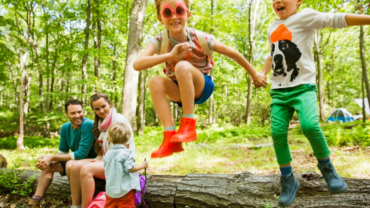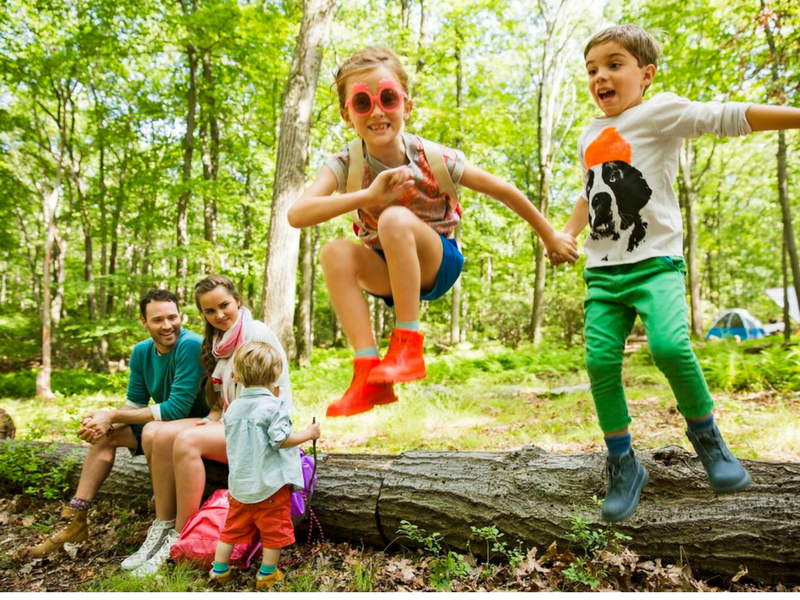Via Parents: 19 Tips for Camping With Kids
Leave the screens behind and pitch a tent at your nearest campground for a nature-filled, home-away-from-home your kids won’t forget.
New at This? Camp Like a Champ
Stick to these do’s and don’ts when camping with young kids for the first time.
Don’t rough it. Car camping, in which you drive up to your campsite, is the way to go.
Plan ahead. Campgrounds, especially those in national and state parks, fill up quickly. Best to book six to nine months in advance. ReserveAmerica.com is the largest provider of campsite reservations in North America.
Conduct a test run. Try sleeping in a tent in the backyard first, suggests Vicki Wright, Girl Scouts of the USA Outdoor Initiative Lead. Take notes as you think of things you’ll need on a full-blown trip.
Rent a tent. Or borrow one instead, advises Wright. Public parks often have programs to lend camping equipment. You can also rent gear from websites like OutdoorsGeek.com.
Don’t overpack. Most people bring too many clothes, says Toby O’Rourke, of Kampgrounds of America. Leave the “just-in-case” items at home and know that you can re-wear things.
But do pack for all kinds of weather. Even if it’s hot during the day, the evenings can be cool—so bring an extra layer or fleece pullover/pants for nighttime, suggests Tom Kimmet, general merchandising manager at REI. Don’t neglect rain gear!
Unpack and set up camp while you still have light. Get the kids involved with a chore, like gathering kindling. Set up the tent first. Then, if you’re planning to cook over a fire, get it going right away (see our tips below).
Don’t be overambitious on Night 1. If you’re arriving at the end of the day, plan a super-simple meal.
Stick to your usual routine as much as possible, especially with young kids. Follow the same bedtime rituals and nap schedule to ensure a good (okay, a decent) night’s sleep.
Don’t unpack your devices. Leave the tablets at home, dig out your digital camera (or forgo pics), and stash your smartphones in the car for emergencies.
How to Build a Campfire
A roaring campfire is half the fun of camping—that is if you can get the darn thing lit. (Pro tip: Buy wood at the campsite. Many don’t allow you to bring from outside their forest.) Follow the advice of Tom Kimmet of REI for fire-building success:
- Bring some newspaper for kindling, and pack more than one source of fire, like matches and a lighter (in case one fails you). Fire-starters such as nontoxic Lightning Nuggets can also help start your blaze.
- Make a square using four large pieces of dry wood. Then put a pile of crumpled newspaper in the middle.
- Create a tepee shape of smaller wood pieces (#2-pencil size) inside the square of logs, directly on top of and around the newspaper kindling.
- Crosshatch mid-size pieces through the tepee in a #-shape.
- Light two or three sides of the bottom edge of the crushed paper to start.
- Keep adding to the # as needed to keep the fire going.
- Before you go to sleep, drown your fire with a 5-gallon bucket of water.
Breakfast Camp Bread
Whether you make homemade dough or cheat with biscuit dough from a can like we did, this campfire-cooked bread is a hit with kids. Simply stretch and wrap the dough around one end of a long, clean stick. Sprinkle with 1 tsp. Cinnamon-Sugar Mix for a hint of sweetness. Grill above the coals for about 5 minutes.
Pack Like a Pro
Check out our Ultimate Camping Packing List for a full list of everything you’ll need for a camping weekend with kids, including must-haves, nice-to-haves, and little luxuries. Plus, don’t forget these items that Parents editors and their family members say they couldn’t live without:
“I pack scissors to easily open packages of food, but I’ve also used them to free cords of wood and cut rope into a laundry line. I know a real outdoors woman would use a pocket knife, but I feel safer with scissors!” admits entertainment editor Jessica Hartshorn.
“Bring a winter hat,” says Declan O’Connor, son of senior editor Gail O’Connor. “At night it can get really cold, even in your sleeping bag.”
“I always pack a long rope to rig between two trees, where we hang wet stuff to dry—and also food, if we’re in an area with bears,” says deputy art director Maria Stegner.
“Forget instant coffee. I recommend a French-press coffee mug,” says editor-in-chief Dana Points.
“Come prepared with extra heavyduty garbage bags,” advises food stylist Stephana Bottom, who uses them to bag up sooty camp cookware at the end of the trip.
“Don’t leave home without a spade or small shovel,” warns executive editor Chandra Turner, who notes that you may need it for discreet bathroom trips.
Don’t Forget Lighting
The latest camp lights have extra functionality, like charging electrical devices or repelling bugs. No matter what types of light you choose, make sure you have multiple sources.
The lightweight Scout Lantern creates a 15-by-15-foot mosquito-free zone while also illuminating your campsite.
The mtnGLO Tent Light is a 100-inch strand of LED lights encased in nylon tubing, which clips to your tent frame.



